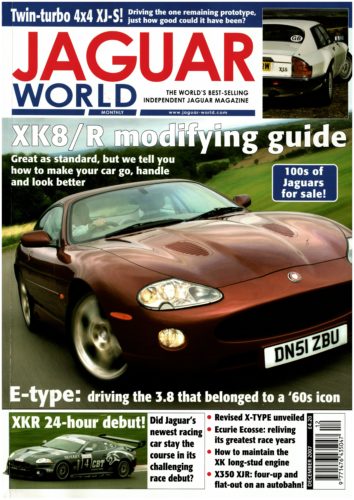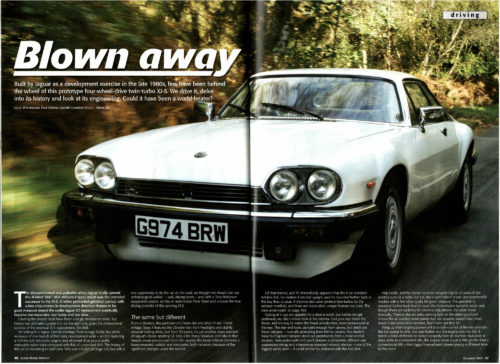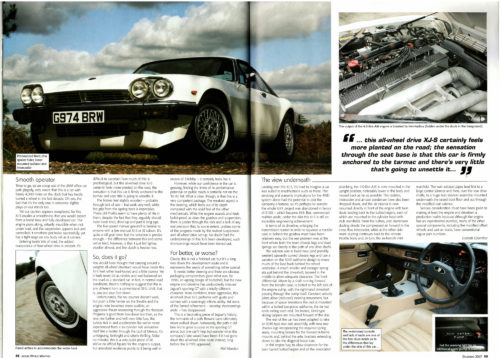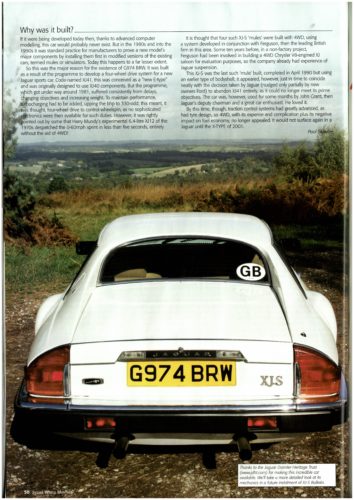Blown Away
Driving Jaguar’s Twin-turbo 4X4 XJ-S!
Reproduced with permission of Jaguar World Monthly Magazine (December 2007)

Jaguar World
December 2007
Built by Jaguar as a development exercise in the late 1980s, few have been behind the wheel of this prototype four-wheel-drive, twin-turbo XJ-S. We drive it, delve into its history and look at its engineering. Could it have been a world -beater?
The disappointment was palpable when Jaguar finally canned the ill-fated ‘XJ41’ (the stillborn F-type) which was the intended successor to the XJ-S. A rather protracted gestation period, with a few criss-crosses in development direction thrown in for good measure meant the svelte Jaguar GT replacement eventually became too expensive, too heavy and too slow.
Canning the project must have been a tough decision to make, but history has ultimately judged it to be the right one, given the phenomenal success of the eventual XJ-S replacement, the XK8.
Yet lurking in a Jaguar Daimler Heritage Trust storage facility lies some evidence of one branch of that early development work – an XJ-S featuring a 4.0-litre AJ6 twin-turbo engine and all-wheel-drive plus a visibly noticeable wider track compared with that of a standard XJ-S. The history of this car is interesting in itself (See ‘Why was it built?’ on page 50) but with a rare opportunity to try the car on the road, we thought we should don our archaeological wellies – well, driving boots – and, with a Tony Robinson-esque enthusiasm, act like an automotive Time Team and uncover the true driving potential of this sporting XJ-S.
The same but different

Jaguar World – December 2027
Blown Away – Twin-turbo XJ-S
G974 BRW Pages 46-47
From a distance, this particular XJ-S looks like any other of late 1980s vintage. Sure, it features the US-style twin front headlights and slightly unusual looking alloys, but from 50 paces, it’s just another clean example of Jaguar’s classic sporting GT. Step a bit close, however, and take in that deeper, more pronounced front chin spoiler; this lower valance conceals a lower-mounted radiator and intercooler, both necessary because of the significant changes under the bonnet.
Lift that bonnet, and it’s immediately apparent that this is no standard 4.0-litre AJ6. For starters it sits bolt upright, and it’s mounted further back in the bay than is usual. A chrome-clad cover protects twin-turbos by the exhaust manifold, and there are many other unique features too (see, ‘The view underneath’ on page 49).
Gazing at it ups our appetite for a drive a notch, but before we get underway, we take a closer look at the exterior. Cast your eye down the flanks, and it’s easy to notice the flared wheelarches, most pronounced at the rear. The rear end looks standard enough from above, but check out those tailpipes – normally protruding from the far corners, this model’s basic but big-bore tailpipes stand out prominently from a more central location. Peer underneath and you’ll observe a completely different rear suspension set-up and a transverse mounted exhaust silencer – one of the biggest we’ve seen – it could almost be confused with the fuel tank.
Hop inside, and the fascia has been stripped slightly of some of the niceties such as a radio, but it is also a neat hybrid of pre- and post-facelift models with a few other quirks for good measure. The gearlever is mounted further back than is usual, the transmission tunnel is wider and, though there are switches for electrical adjustment, the seats move manually. There is also an extra warning light on the steering column shroud for an auxiliary water pump that, we assume, would have never made it into production versions, had it ever got that far.
Firing up that intriguing power-unit is simple – a flick of the key prompts the fuel pump to whir, one turn further and the engine stirs into life. It needs a tickle of throttle to wake it properly from its slumber; but when it does settle to a consistent idle, the engine noise is just a little gruffer than a conventional AJ6 – that bigger bore exhaust clearer playing a different tune to the norm.
Smooth operator

Jaguar World – December 2027
Blown Away – Twin-turbo XJ-S
G974 BRW Pages 48-49
Time to go, we creep out of the JWM office car park gingerly, very aware that this is a car with barely 4,000 miles on the clock that has hardly turned a wheel in the last decade. Oh yes, the fact that it’s the only one in existence slightly plays on our minds too …
Yet our caution appears overplayed, for this XJ-S exudes a smoothness that you would expect from a brand new and fully developed car. The engine purrs along, virtually inaudible when not under load, and the suspension appears taut and controlled; it smothers pot-holes successfully, yet has a tight reign on any body roll as it corners.
Entering twisty bits of road, the added reassurance of four-wheel drive is evident. It’s difficult to ascertain how much of this is psychological, but this all-wheel drive XJ-S certainly feels more planted on the the road; the sensation is that this car is firmly anchored to the tarmac and very little is going to unsettle it.
The brakes feel slightly wooden – probably through lack of use – but work very well, while the grip from the ageing tyres is impressive. These old Pirellis seem to have plenty of life in them, despite the fact they they arguably should have been tired, dried up and past it, long ago.
The five-speed manual gearshift is familiar to anyone with a late manual XJ-S or XJ saloon. It’s quite a tall gear lever, but the selection is precise enough – the difference between this and some we’ve tried, however, is that it just felt tighter, sturdier almost, and the clutch is heavier too.
So, does it go?
You would have thought that carrying around a weighty all-wheel drivetrain would have made this XJ-S feel rather lead-footed and a little clumsy. Yet it feels every bit as nimble and well-balanced on the road as a standard car. In fact, in normal road conditions, there’s nothing to suggest that this is any different from a conventional XJ-S. Until, that is, you put your foot down …
Unfortunately, the rev counter doesn’t work, but push a little harder on the throttle and the engine note becomes more audible, an aggressive thrum resonating through the floor-pan. Progress is good from low-down but then, as the revs rise further and with very little fuss, the turbos kick in and acceleration like we’ve never experienced from a six-cylinder AJ6 unleashes itself like a twister through the Gulf of Mexico. It’s unforgiving, this is a very quick piece of kit. We’ve no official figures for the engine’s output, but anecdotal evidence points to it being well in excess of 330 bhp – it certainly feels like it.
However, while our confidence in the car is growing, finding the limits of its performance potential on public roads is certainly not on the ‘to do’ list. What is clear though, is that this is a very competent package. The weakest aspect is the steering, which feels out of its depth compared with the solid feel of the other mechanicals. While the engine sounds and feels bullet-proof, as does the gearbox and suspension, there is judder through the rack and a lack of any real precision that, to some extent, undoes some of the progress made by the revised suspension and all-wheel drive set-up. No doubt had the underpinnings of this XJ-S been developed, such shortcomings would have been ironed out.
For better, or worse?
Clearly, this is not a finished car, but it’s a long way down the development route and it represents the seeds of something rather special.
It needs better steering and there are obvious packaging compromises given what was, by 1990, an ageing design of bodyshell; but the new engine and driveline has undoubtedly imbued Jaguar’s sporting GT with a totally different character. More confident, more aggressive, this all-wheel drive XJ-S performs with gusto and corners with a seemingly infinite ability. Yet none of the famed refinement – steering shortcomings aside – has disappeared.
This is a fascinating piece of Jaguar’s history; the remnants of a path Browns Lane ultimately never walked down. Fortunately, the path it did take led to great success in the sporting GT arena; but one can’t help but wonder what the company’s fate would have been been if it had gone down this all-wheel drive instead, long before the X-TYPE appeared.
Phil Weeden
The view underneath
Looking over this XJ-S, it’s hard to imagine a car less suited to modifications such as these. The servicing and warranty implications for the 4WD system alone had the potential to cost the company a fortune, so it’s perhaps no wonder the whole XJ41 project was abandoned in favour of X100 – which became the XK8. But, commercial realities aside, under the skin this XJ-S is still an incredible engineering achievement.
In terms of its driveline, enlarging the transmission tunnel in order to squeeze a transfer case in behind the gearbox must have been relatively easy, but the real problem was at the front where both the main chassis legs and road springs sat directly in the path of any new drive shafts.
The solution was to build new (and possibly weaker) upwardly curved chassis legs and use a variation on the XJ40 subframe design to move much of the load back behind the wheel centre-line. A much smaller and stronger spring sits just behind the driveshaft, tapered in the middle to allow adequate clearance. The front differential, driven by a shaft running forward from the transfer case, is bolted to the left side of the engine sump, with the right-hand driveshaft passing through the the sump itself. Constant velocity joints allow (reduced) steering movement, but because of space limitation the rack is mounted within a bolted two-piece subframe, the tie rod ends exiting each end. For brakes, XJ40-type sliding calipers are mounted forward of the disc.
The rear of the car has been adapted to take an XJ40-type rear axle assembly, with new rear chassis legs incorporating the required spring seat, mounting bosses for the forward A-frame mounts and, behind the axle, brackets extending down to take the diagonal brace bars.
In the engine bay, to allow clearance for the twin Garrett turbochargers and all the associated plumbing, the 4.0-litre AJ6 is now mounted in the upright position, noticeably lower in the body and moved back as far as possible. The radiator, intercooler and air-con condenser have also been dropped down, and the air cleaner is now mounted directly in front of the engine with twin ducts leading back to the turbochargers, each of which are mounted to the cylinder head with stub manifolds. From the turbos, cast aluminium ducting directs the compressed air forward to the cross flow intercooler, while at the other side more ducting continues back to the remote throttle body and, in turn, the six-branch inlet manifold. The twin exhaust pipes lead first to a large central silencer and then, over the rear drive shafts, to a huge twin silencer assembly mounted underneath the raised boot floor and out though the modified rear valance.
Serious consideration must have been given to making at least the engine and drivetrain a production reality because although the engine has an experimental number, many of the other special components, including the modified offset wheels and cast air ducts, have conventional Jaguar part numbers.
Garreth Coomber
Why was it built?

Jaguar World – December 2027
Blown Away – Twin-turbo XJ-S
G974 BRW Page 50
If it were being developed today then, thanks to advanced computer modelling, this car would probably never exist. But in the 1980s and into the the 1990s it was standard practice for manufacturers to prove a new model’s major components by installing them first in modified versions of the existing cars, termed mules or simulators. Today this happens to a far lesser extent.
So this was the major reason for the existence of G974 BRW. It was built as a result of the programme to develop a four-wheel drive system for a new jaguar sports car. Code-named XJ41, this was conceived as a “new E-type” and was originally designed to use XJ40 components. But the programme, which got underway around 1981, suffered consistently from delays, changing objectives and increasing weight. To maintain performance, turbocharging had to be added, upping the bhp to 330-odd; this meant, it was thought, four-wheel drive to control wheelspin, as no sophisticated electronics were then available for such duties. However, it was rightly pointed out by some that Harry Mundy’s experimental; 6.4 litre XJ12 of the 1970s dispatched the 0-60 mph sprint in less than five seconds, entirely without the aid of 4WD!
It is thought that four such XJ-S ‘mules’ were built with 4WD, using a system developed in conjunction with Ferguson, then the leading British firm in this area. Some ten years before, in a non-factory project, Ferguson had been involved in building a 4WD Chrysler V8-engine XJ saloon for evaluation purposes, so the company already had experience of Jaguar suspension.
This XJ-S was the last such ‘mule’ built, completed in april 1990 but using an earlier type of bodyshel; it appeared, however, just in time to coincide neatly with the decision takne by Jaguar (nudged only partially by new owners Ford) to abandon XJ41 entirely, as it could n longer meet its prime objectives. The car was, however, used for some months by John Grant, then Jaguars deputy chairman and great car enthusiaast. He loved it.
By this time, though, traction control systems had greatly advanced, as had tyre design, so 4WD, with its expense and complication plis its negatove impact on fuel economy, no long appealed. It would not surface again in a Jaguar until he X-YPE of 2001.
Paul Skilleter
Words: Phil Weedon, Paul Skilleter, Garreth Coomber
Photography: Adam Tait